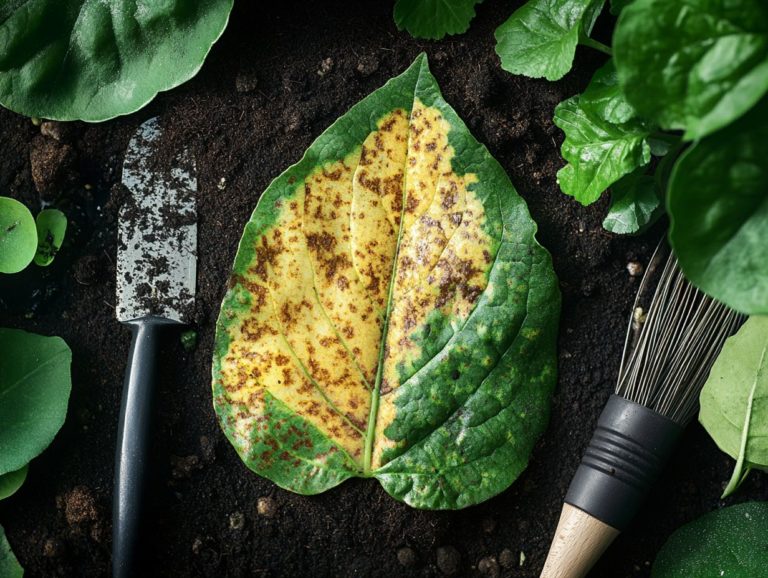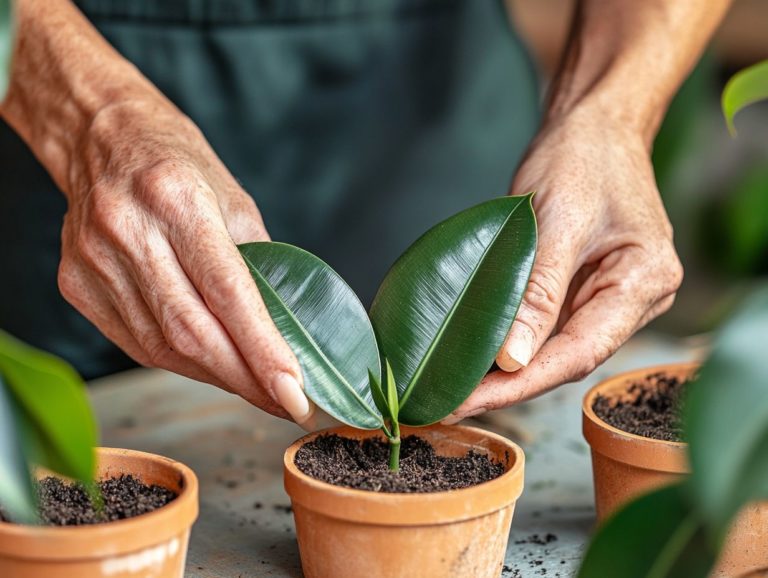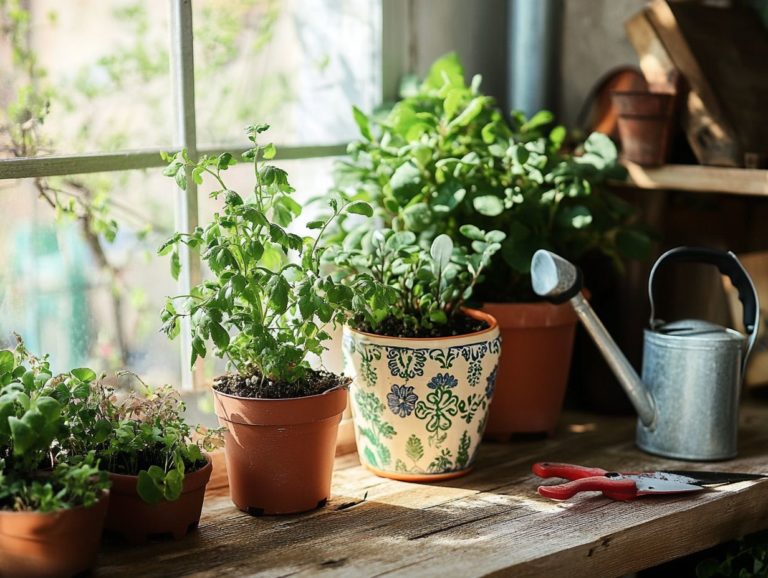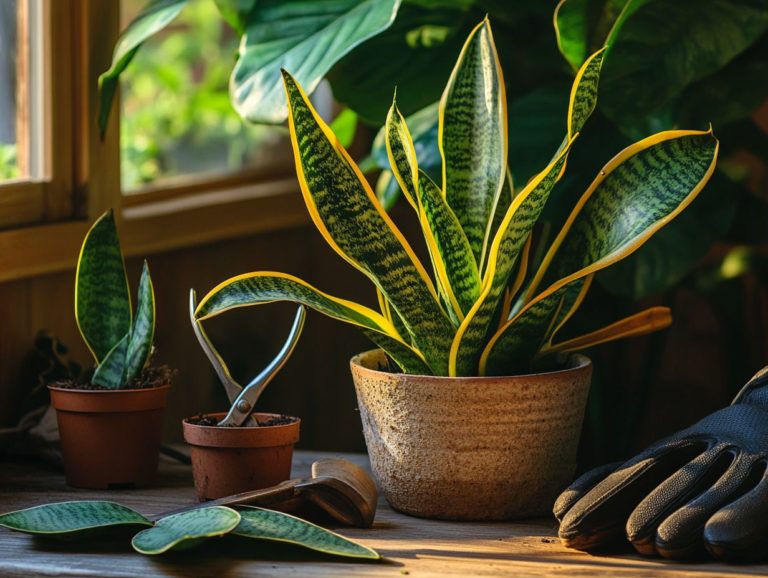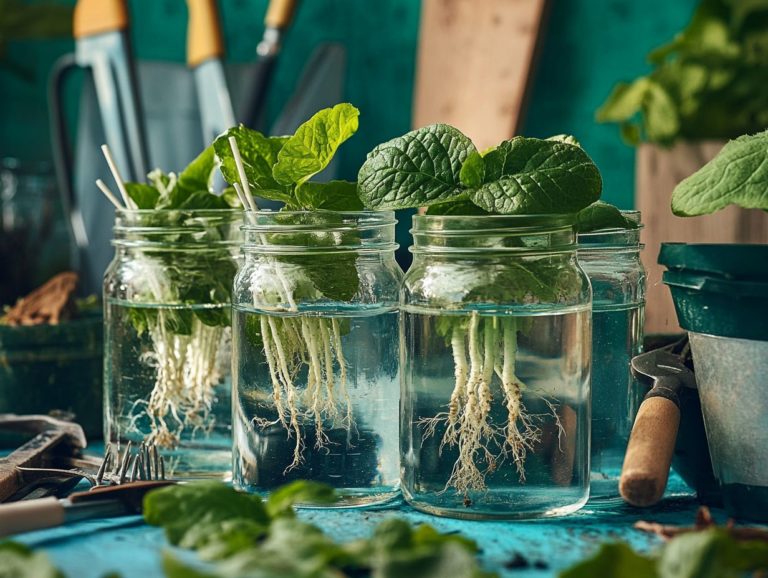How to Care for Your Cuttings While They Root
Rooting cuttings offers a rewarding opportunity to propagate your favorite plants, transforming a single specimen into a flourishing collection. Get ready to unleash your inner gardener!
Grasping the nuances of cuttings from preparation and rooting methods to cutting maintenance and care can profoundly boost your success rate.
This article delves into the essentials of rooting cuttings, covering the necessary tools, effective techniques, and tips for recognizing when your cuttings are primed for their next stage.
Contents
Key Takeaways:
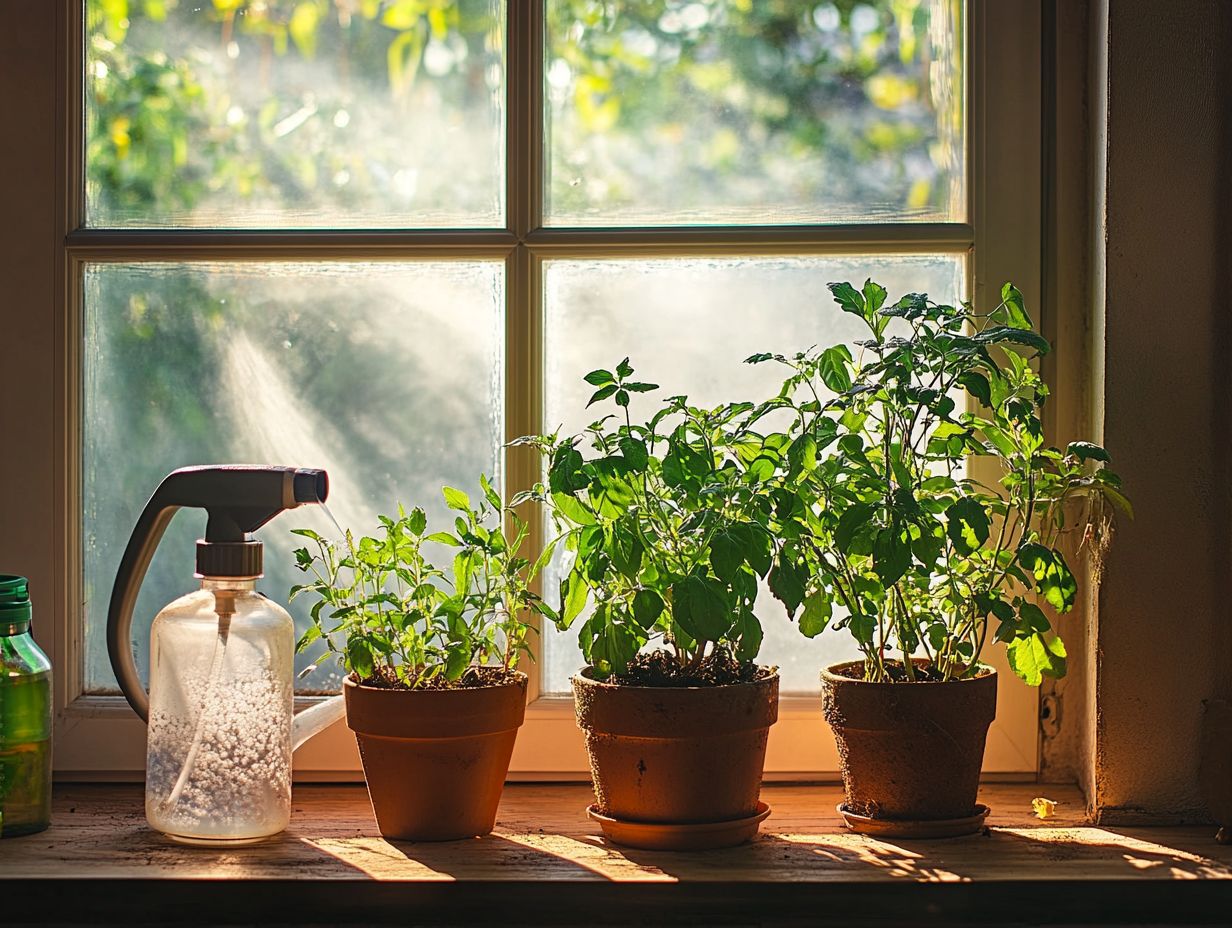
- Understanding the process of rooting cuttings is essential for successful propagation.
- Proper care and preparation of cuttings, including choosing the right time and method, are crucial for successful rooting.
- Choosing the right rooting medium, providing the right environment, and monitoring signs of successful rooting are key factors in caring for your cuttings.
Why Rooting Cuttings is a Game-Changer for Your Garden!
Understanding the process of rooting cuttings is vital for anyone looking to propagate their favorite plants. This technique involves taking a portion of a plant, known as a cutting, and nurturing it until it develops healthy roots and can thrive.
Rooting cuttings can be a truly rewarding experience. It allows you to expand your collection without relying on seeds or fully grown plants. The propagation process demands careful attention to factors like humidity levels and using a special plant hormone to ensure success.
Diving into the intricacies of this method enables you to cultivate mature plants that flourish in various conditions.
What are Cuttings and Why Root Them?
Plant cuttings are sections of a plant that you can snip off and root to create new, healthy specimens. This propagation method is cost-effective and allows you to clone your favorite varieties easily.
As you cultivate cuttings, you may witness remarkable root growth, leading to thriving new plants that showcase all the wonderful attributes of their parent plants. Whether it s a cherished houseplant or a striking ornamental flower, the satisfaction from replicating these horticultural gems is truly rewarding.
Propagating cuttings can significantly reduce your need to purchase new plants, making this an economical choice for both seasoned gardeners and enthusiastic beginners.
Preparing Cuttings for Rooting
Preparing cuttings for rooting is an essential step in the propagation process. This ensures that each cutting has the optimal chance of developing robust roots. It starts with selecting the right plants, making precise cuts to the stems, and applying rooting hormone to encourage root development.
Using cutting trays and a humidity dome will help maintain the ideal conditions for your cuttings, promoting their thriving during this critical stage. By prioritizing proper preparation, you set the foundation for successful propagation. Start preparing your cuttings today for a lush garden tomorrow!
Choosing the Right Time and Method
Selecting the right moment to take cuttings is crucial for successful propagation. This often hinges on the specific plant species and prevailing environmental conditions.
Understanding seasonal factors like when a plant enters its active growth phase can significantly boost your chances of encouraging root formation. Spring and early summer are particularly advantageous, as plants awaken from dormancy and display vigorous growth.
Choosing the ideal growth stage for your cuttings is important; softwood cuttings typically outperform hardwood ones in terms of rooting success. Using a rooting hormone can enhance your outcomes, promoting faster root development and helping your cuttings flourish where moisture and humidity are expertly managed.
Tools and Supplies Needed

Having the right tools can greatly boost your chances of successfully propagating cuttings. The right equipment creates the best conditions for growth and simplifies the process.
A suitable container is crucial. It ensures proper drainage and provides enough space for roots to grow.
Using cutting trays helps you manage multiple cuttings easily. Don’t overlook rooting hormone; it encourages faster root development.
Combining these tools creates an ideal setting for your cuttings to thrive. Get ready for a rewarding gardening experience!
Rooting Mediums and Techniques
Select the right rooting medium and techniques to nurture healthy roots. You can choose from mediums like perlite and hydroton, both excellent for supporting root growth.
Try different propagation techniques to boost your success. Regularly changing the water and using a mix of mediums can create ideal conditions for robust root development.
Understanding these elements will enhance your propagation efforts and make you a better plant parent.
Types of Mediums and How to Use Them
You have a variety of mediums for rooting cuttings, each offering unique benefits. For example, perlite improves airflow and drainage, ideal for drier conditions.
Peat moss retains moisture, helping maintain humidity during rooting. Coco coir balances water retention and drainage for various plant types.
Rock wool enhances moisture management and root aeration, promoting faster growth. Know how these mediums work to elevate your propagation success!
Caring for Cuttings During Rooting
Caring for your cuttings requires attention to environmental factors like humidity and light. Proper temperature control is vital for successful propagation.
Balancing indirect light with adequate airflow fosters healthy growth. Create the right conditions, and watch your cuttings flourish!
Light, Temperature, and Humidity Requirements
Understanding the light, temperature, and humidity needs of your cuttings is crucial. Set the stage for optimal growth by providing indirect light to avoid stress.
Aim to maintain temperatures between 65 to 75 degrees Fahrenheit. Fluctuations can slow down rooting.
Keep humidity levels between 60% to 80% to enhance moisture retention for delicate cuttings. For detailed methods, check out how to water plant cuttings effectively. Manage these elements for maximum success in rooting!
Signs of Successful Rooting
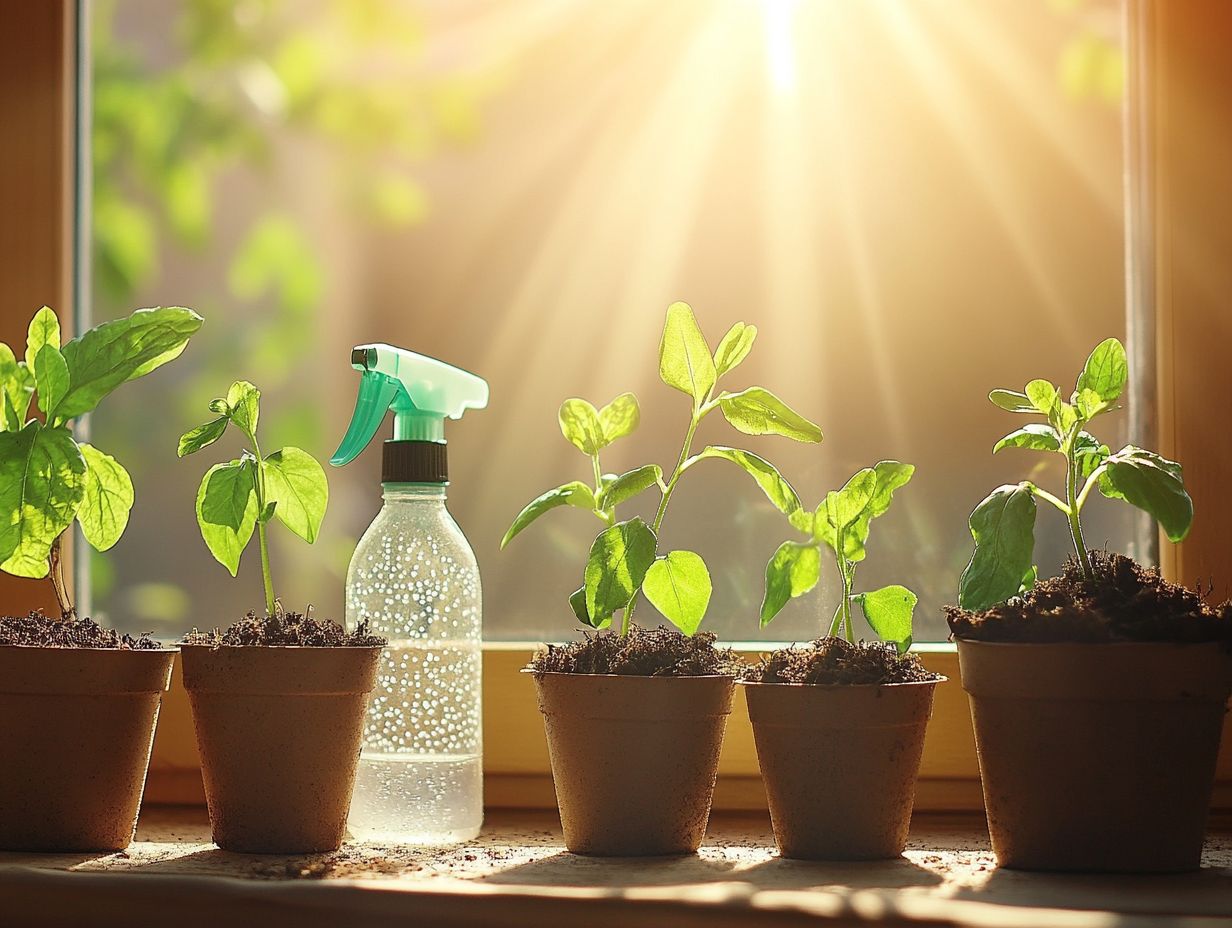
Recognizing the signs of successful rooting is crucial for you as a dedicated plant parent eager to transplant your cuttings into the soil. When you observe changes in the cutting, such as the emergence of healthy roots or root initials, it s a clear indication that your propagation efforts have paid off. This allows you to cultivate healthy plants.
By regularly monitoring their progress, you can ensure that your cuttings are primed for the next phase of growth and ready for transplanting. Understanding these signs gives you the power to propagate more effectively, leading to a flourishing indoor garden that reflects your care and attention.
How to Tell if Your Cuttings Have Rooted
Determining whether your cuttings have successfully rooted requires keen observation of specific physical signs. Healthy roots forming is a positive indicator, so check on the roots regularly during this stage.
Start with visual checks, as these can reveal important features like the emergence of new growth or the appearance of small roots pushing through the drainage holes in the pot. A gentle tug on the cutting provides tactile feedback; if you feel a slight resistance, that’s a promising sign that root establishment is underway. It’s essential to monitor root health, as it directly influences the future vitality of your plant.
Once you’re confident that the roots are well developed, you can move forward with transplanting. Just be sure to select an appropriate pot size and soil type that will nurture further growth.
Transferring Rooted Cuttings
Transferring your rooted cuttings to their new homes is an exciting step forward! This signifies the transformation from mere cuttings to robust, healthy plants. The propagation process is essential for every plant parent looking to propagate cuttings successfully.
To make this transition seamless, it’s vital to prepare your cuttings adequately. Mastering proper transplant techniques will not only support their health but also enhance their stability in their new surroundings.
Maintaining careful attention to your cuttings will help you prevent water loss. Use a humidity dome and monitor humidity to set the stage for your new plants to flourish. Grasping the nuances of effective transplantation can pave the way for a thriving indoor garden that you can truly be proud of.
When and How to Move Cuttings to Their Permanent Home
Knowing when and how to transfer cuttings to their permanent home is key to their continued health and growth, especially when considering their temperature control and humidity levels.
Recognizing the signs that it s time for transplanting can significantly enhance your plant s development. Watch for roots that start to outgrow their current container or signs of wilting, which may indicate that they are becoming root-bound. This is a crucial time to consider using a rooting hormone (a substance that helps roots grow faster) for improved root growth.
When you’re ready to move your cuttings, handle them gently to minimize stress. Before transplanting, ensure that the new location features well-draining soil like hydroton that promotes drainage and reduces the risk of overwatering. For more detailed guidance, check out this article on how to grow new plants from cuttings.
Keep a close eye on moisture levels; maintaining proper hydration while monitoring temperature during this transition is crucial to prevent water loss and encourage strong establishment in their new environment. Act quickly to give your plants the best chance to thrive!
Frequently Asked Questions
How should I care for my cuttings?
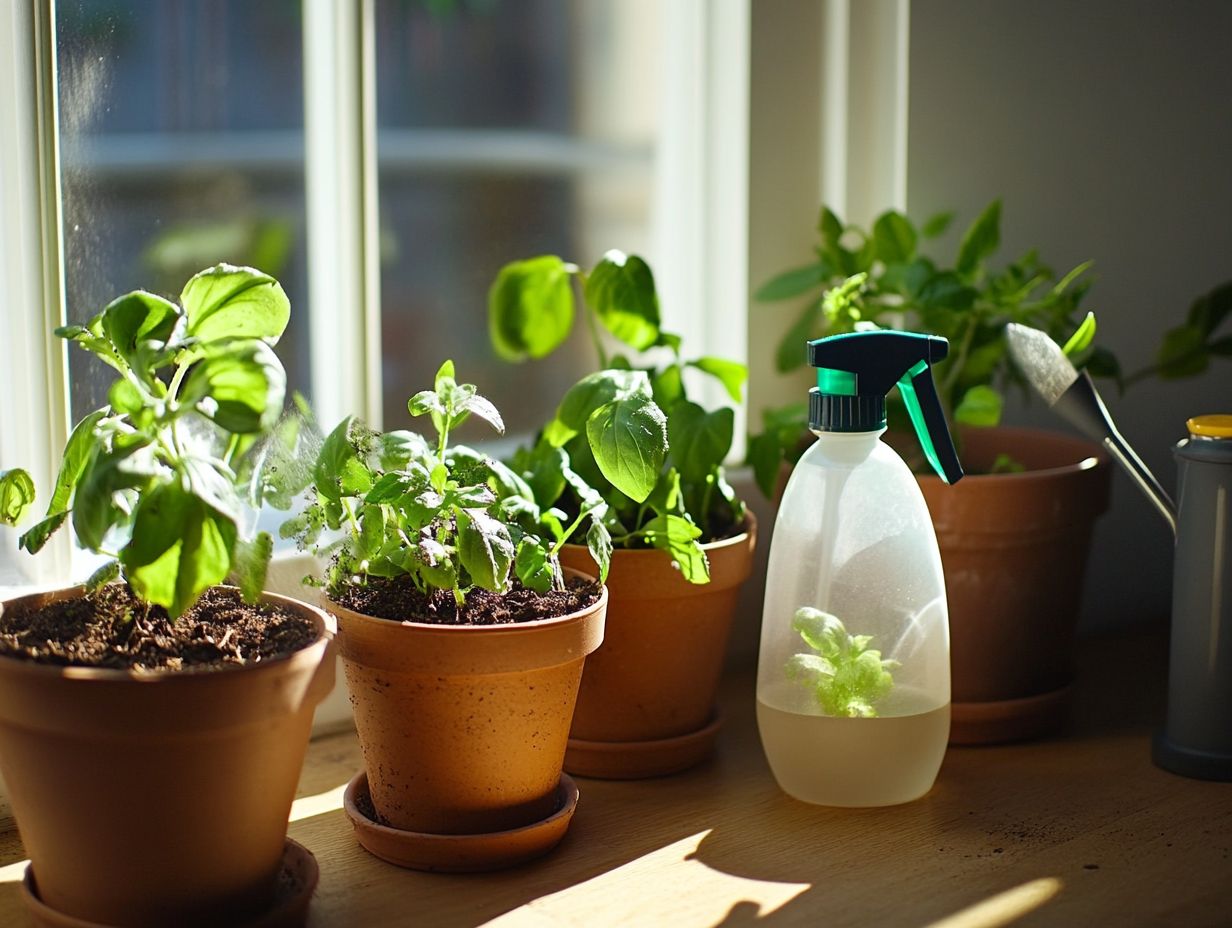
To care for your cuttings while they root, you will need to provide them with proper indirect light, moisture, and nutrients. This will help them establish a strong root system and ensure their overall health.
When should I water my cuttings while they root?
You should water your cuttings while they root whenever the top inch of soil feels dry to the touch. It’s important not to overwater them as this can lead to root rot, particularly in cutting trays where excess water can accumulate.
Do I need to use a rooting hormone for my cuttings?
Using a rooting hormone a substance that helps plants grow roots can greatly increase your success rate. It stimulates root growth and can help prevent diseases.
How much light do cuttings need while they root?
Cuttings thrive in bright, indirect light. A setup with fluorescent lights, like the Agrobrite T5, provides just the right light without drying them out.
How often should I fertilize my cuttings while they root?
Wait until your cuttings develop a strong root system before fertilizing. Once established, use a flowering fertilizer every 2-3 weeks to promote optimal growth.
What is the best temperature for cuttings while they root?
The ideal temperature for rooting cuttings is between 65-75 F (18-24 C). Use a seedling heat mat for extra warmth and avoid extreme temperature changes to encourage healthy roots.

